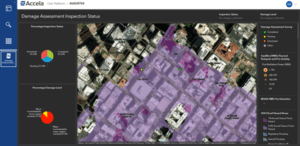 Natural disasters are a fact of life and are increasing in regularity and impact. Some attribute this to climate change—which can create more weather-related events such as storms, hurricanes, floods, and cyclones. It can also result in higher average temperatures which increase drought conditions and the potential of devastating fires, causing serious damage to property, infrastructure, and lives.
Natural disasters are a fact of life and are increasing in regularity and impact. Some attribute this to climate change—which can create more weather-related events such as storms, hurricanes, floods, and cyclones. It can also result in higher average temperatures which increase drought conditions and the potential of devastating fires, causing serious damage to property, infrastructure, and lives.
“How many natural disasters are there? In the last three years (2020s), the U.S. experienced an average of (20) billion-dollar disasters per year, up from (12.8) billion-dollar disasters per year in the 2010s and (6.7) billion-dollar disasters per year in the 2000s.” NOAA: 2022 U.S. Billion-Dollar Weather and Climate Disasters in Historical Context
Natural disasters also impact a very large percentage of the country. According to a Forbes Advisor report, in the decade from January 2013 to January 2023, 88.5% of all U.S. counties declared a natural disaster including 95% of the 200 most populated counties.
When Disaster Strikes
When natural disasters hit, we often see neighbors rallying to help each other, and local governments working to assess damage, ensure safety, and aid in rebuilding. Sometimes the federal government steps in to provide personnel, equipment, and funding to help communities with the recovery process.
Accela’s technology can play an important role in helping community governments prepare for natural disasters, respond when they occur, and facilitate the rebuilding process in the aftermath. This blog describes how we do that.
Disaster Preparedness is Critical for Public Safety
Dealing with natural disasters starts with preparedness. This is the ongoing process government agencies undertake to ensure their communities are following established codes. These include:
- Building codes are important to ensure structures and infrastructure are built and maintained according to proper construction methods. The more structures that adhere to codes, the safer residents are in the case of a disaster.
- Fire codes play a key role in preventing damage from wildfires and other disasters that can be triggered by fire. This includes inspecting buildings for fire safety, tracking and citing areas with overgrowth in populated areas, and flammable liquid storage.
- Code enforcement involving hazardous and bio-hazardous material handling can prevent mishandling or exposure in the case of a disaster. Often municipal Fire and Health departments work together to ensure these codes are adhered to.
For ongoing preparedness, many agencies use Accela’s pre-built Civic Applications to automate code enforcement, licensing and permitting. These solutions include:
- Civic Application for Planning – to ensure the zoning, planning, and safety strategies are adhered to
- Civic Application for Building – to manage the construction permitting and inspection processes
- Civic Application for Fire Prevention – to ensure fire hazards are reduced
- Civic Application for Environmental Health – to ensure a wide variety of safety protocols are adhered to
Disaster Response and Assessment Immediately After an Event
Once a disaster strikes, communities must react immediately. Depending on the type of disaster, the first steps are rescue and safety operations for residents in distress.
Next, damage assessment takes place to ensure any remaining risk of damage or danger is managed, and there is a clearer understanding of the recovery process and resource requirements.
Rapid Damage Assessment
Rapid Damage Assessment (RDA) for communities involves immediate inspection and data collection by agency staff and can be assessments of individual parcels or entire areas. We often see “windshield” surveys where inspectors drive to affected sites and assess status from a first impression visual inspection that occurs from their vehicles or by physically walking from property to property, filling in forms and capturing photos. They can also utilize drones and video to assess damage after an event.
Rapid Damage Assessment is important because if an area’s damage meets certain criteria, local agencies use this information to expedite the reporting and application processes for FEMA funding. The potential for federal funding is critical for recovery and rebuilding functions with major events, and communities want to start this application process as quickly as possible.
A key technology for damage assessment and FEMA reporting is using GIS, or Geographic Information Systems. This allows data capture and analysis in map formats to better visualize the areas being affected by the event in relation to other areas. Various types of geospatial data can be captured in layers on maps, and agencies often create layers for themselves, FEMA reporting, and other entities that need assessment data. All Accela products include deep integration with Esri’s ArcGIS technology.
Accela provides a pre-built Rapid Damage Assessment module provided at no cost with our Building Civic Application, which agencies can use to improve their ability to capture information in the field. It is flexible to accommodate agencies that may want very simple data capture for their RDA, and others that may want more detailed and comprehensive assessment data.
This solution includes:
- Record types specific to damage assessments
- Pre-built checklists for inspectors for damage assessment
- Ability to capture pictures and video and attach them to the record, including drone video
- Ability to work offline – critical in case of natural disaster
- GIS data capture and analysis
Another key benefit is that Accela RDA is integrated with Accela’s back-end system to capture and retain all data and help facilitate the FEMA reporting and application function in a fully digital process.
Service Request Management
Another critical function with disaster response is ensuring residents have a way to report damage themselves via a “311” reporting capability. Accela’s Civic Application for Service Request enables residents to report non-emergency flooding, potentially unsafe structures, fallen trees, etc. via their mobile phones. This is especially valuable when damage is extensive, and resources are strained.
Need For Efficient Cleanup and Rebuilding
The final phase of a natural disaster is the rebuilding process that takes place afterwards. It is critical to get people back in their homes and structures and get their lives back to “normal” as quickly as possible. It is also vital to ensure much needed public infrastructure, such as roads, bridges, dams, power facilities, etc. are to code and operational.
The key is for agencies to provide mechanisms to avoid long permitting and inspection cycles, which slows the rebuilding process. Providing some degree of automating plan approvals, immediate granting of permits for certain elements of construction (or instituting “same day” permitting), and/or allowing builders to conduct and document their own inspections, speeds approval and rebuilding timeframes. And, of course, having permitting, licensing, and code enforcement centralized in a fully digital, online environment is a necessity for the needed automation and efficiencies to meet the requirements of residents.
Accela has direct experience with helping agencies automate the rebuilding process. Charlotte County in Florida used Accela to automate the planning, permitting and inspection functions after both hurricanes Irma in 2017 and Ian in 2022. When a massive fire destroyed close to 19,000 structures the town of Paradise in Butte County, California, Accela was used to ensure high speed and efficiency in their rebuilding process. In fact, many other Florida-based agencies use Accela due in part to weather events in the areas. These include the counties of Manatee, Hillsborough, Pinellas, Polk, Osceola, Pasco, and others.
Accela’s solutions and technologies helping with rebuilding include:
- Civic Application for Building
- Civic Application for Planning
- Accela Citizen Access
- Accela Mobile
- Accela GIS
They are all designed to get rebuilding construction underway as fast as possible, and Accela customers report a dramatic decrease in time to approve permits for builders and huge jumps in the number of permit applications and inspections scheduled on their website instead of coming into the office, saving time and money.
We consistently see residents gravitating to secure online portal environments for submitting permit applications, uploading relevant documents, and scheduling inspections. They can access the portal from any device, 24/7, and track their application status, fees due, and online payments. With more using sites such as Amazon or eBay for consumer needs, it’s no wonder they expect the same speed and convenience from their government agencies, especially in time of crisis.
Summary
Accela wants to partner with agencies in their disaster preparedness efforts, disaster response and assessments, and in the rebuilding functions. Our software can directly improve the speed of these functions, improving the quality of life for residents. In addition, our in-house team of experts are here to ensure best practices are in place. If you are a customer jurisdiction in need of property and inspection assistance before, during or after a catastrophic event, please contact us at DisasterRelief@accela.com.






